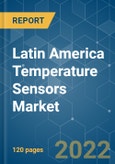The Latin American temperature sensor market was valued at USD 594.5 million in 2020, and it is projected to be worth USD 913.6 million by 2026, registering a CAGR of 7.4% during the period 2021-2026.
Key Highlights
- Latin America is one of the leading adopters and promoters of smart technology in various industries, such as consumer electronics, oil, gas, power generation, aerospace, and automotive.
- According to the Associação Nacional dos Fabricantes de Veículos Automotores (ANFAVEA), As of February 2020, there are more than 7,500 hybrid and electric vehicles in circulation. Electric vehicles significantly utilize temperature sensors, making the automotive sector one of the country's prominent users of temperature sensors.
- Among other countries in the region, Mexico has traditionally been the dominant producer of oil and is being considered the world's new oil frontier with a potential to add three Million BPD to the global output during the next decade.
- Temperature sensors were readily used in combat against covid-19. In May 2020, the Juscelino Kubitschek Airport in Brazil announced the implementation of a body-heat sensor system for domestic departures. The system measures the temperature of 30 people at a time and can differentiate normal body temperatures from other sources of heat.
Key Market Trends
Automotive Industry to Show Significant Growth
- The automotive sector of the region is a significant user of temperature sensors. Companies such as Intel, which are focusing on the autonomous vehicle space, are investing in Mexico. The sales of electrified vehicles in the country have increased at a two-digit pace, although the demand for electric cars is growing slower than that of hybrid units.
- According to the data made available by the National Institute of Statistics and Geography (INEGI), auto dealers in Mexico sold 353 electrified vehicles between January 2019 and February 2020.
- Moreover, The National Agency of Electric Energy (ANEEL) suggests that the number of electric vehicles is expected to rise to 212,000 by 2030. Electric vehicles significantly utilize temperature sensors, making the automotive sector one of the country's prominent users of temperature sensors.
- However, the state of the automotive industry in Argentina has been quite challenging due to the decreasing demand, according to data from Asociación de Fabricantes de Automotores (ADEFA). In response to the decline in demand, three supplier companies of the automotive industry in Argentina have announced the closure of factories (July 2020), with plans of migrating to Brazil. This is expected to hamper the usage of temperature sensors in the automotive sector of Argentina.
Brazil to Hold the Highest Market Share
- Brazil, the largest country in the Latin American region, is one of the leading countries involved in adopting and promoting smart technology in various industries, such as consumer electronics, oil, gas, power generation, aerospace, and automotive.
- BP PLC, an oil and gas firm based out of London, United Kingdom, estimates that Brazil could attract about USD 22 billion worth of investment in the oil sector in each of the next five years. Owing to this, the production is expected to increase to around 3.7 Million BPD by 2025. This has been providing the scope for expansion, possibly in new projects. Such statistics highlight the rising demand for temperature sensors in the sector.
- The country is home to the most prominent representative company named Embraer, a firm that is currently the third-major manufacturer of commercial, military, and executive aircraft in the world. This places the country's aerospace industry as the largest in the Southern Hemisphere. According to BCI Aerospace, the aerospace industry has potential opportunities for annual growth of 5-6% over the next few years.
- Brazil has also been witnessing significant development of smart cities. For instance, Brazil launched a new low-cost smart city, Natal, which is expected to be developed by Planet Smart City. The city is expected to be developed in 170 hectares and to house around 150,000 people. The city is to be developed in partnership with Habitax. Such developments are expected to increase the usage of sensor systems, including temperature sensors.
Competitive Landscape
The Latin America Temperature Sensor market is competitive and consists of several major players. In terms of market share, few of the major players currently dominate the market. These major players with a prominent share in the market are focusing on expanding their customer base across foreign countries. These companies are leveraging on strategic collaborative initiatives to increase their market share and increase their profitability.
- June 2021 - Cold Chain Technologies, an ISO 9001:2015 certified global provider with more than 50 years of developing and delivering smart solutions that protect the integrity of temperature-sensitive products, announced an extensive expansion into Latin America.
Additional Benefits:
- The market estimate (ME) sheet in Excel format
- 3 months of analyst support
This product will be delivered within 2 business days.
Table of Contents
Methodology

LOADING...








